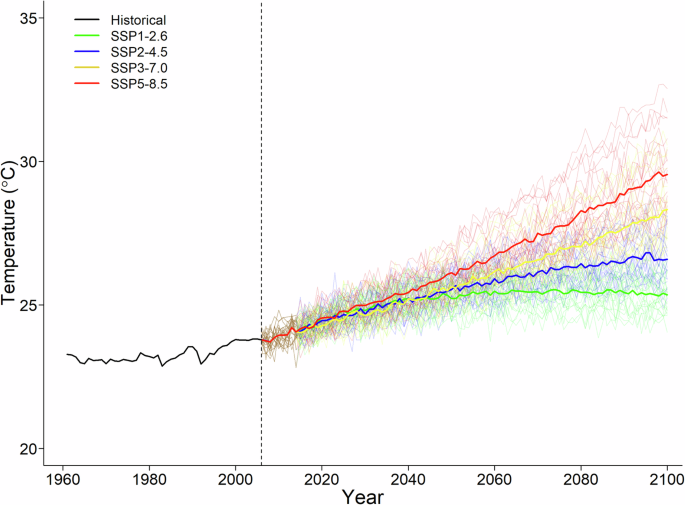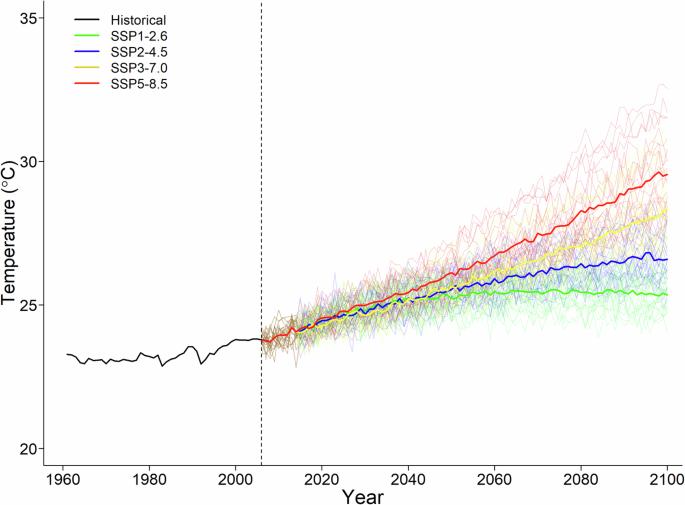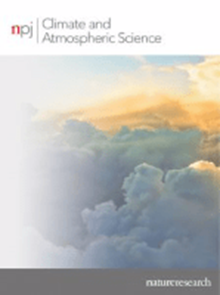Mortality burden of diabetes attributable to high temperature and heatwave under climate change scenarios in China
IF 8.5
1区 地球科学
Q1 METEOROLOGY & ATMOSPHERIC SCIENCES
引用次数: 0
Abstract
Climate change and diabetes pose the dual challenges to human health, yet there is a lack of evidence regarding future health burden of diabetes attributable to climate change. In this study, we used three-stage analytic strategy to project the heat-related and heatwave-related diabetes deaths by demographic characteristics and regions, during 2010–2100 in 32 major Chinese cities. Under SSP5-8.5 (high carbon emission scenario), heat-related attributable fraction of diabetes mortality is projected to rise from 2.3% (95% empirical confidence interval [eCI]: 1.1%, 3.6%) in the 2010s to 19.2% (95% eCI: 10.2%, 32.5%) in the 2090s, and estimated heatwave-related attributable fractions will increase from 0.8% (95% eCI: 0.6%, 1.0%) in the 2010s to 9.3% (95% eCI: 6.7%, 11.8%) in the 2090s. We projected that the number of heat- and heatwave-related diabetes deaths would increase from 1525 (95% eCI: 759, 2431) and 529 (95% eCI: 382, 668) in the 2010s, to 12,956 (95% eCI: 6861, 21,937) and 6312 (95% eCI: 4557, 7972) in the 2090s, respectively. Under SSP1-2.6, SSP2-4.5, and SSP3-7.0 (lower carbon emissions), we projected much lower future heat- and heatwave-related diabetes mortality burdens. Our findings might provide new insights for the development of protecting patients with diabetes from increasing temperature.


气候变化情景下中国高温和热浪导致的糖尿病死亡率负担
气候变化和糖尿病对人类健康构成了双重挑战,但目前尚缺乏有关气候变化导致糖尿病未来健康负担的证据。在本研究中,我们采用三阶段分析策略,按人口特征和地区预测了2010-2100年间中国32个主要城市与热相关和热浪相关的糖尿病死亡人数。在 SSP5-8.5(高碳排放情景)下,与热相关的糖尿病死亡率预计将从 2010 年代的 2.3%(95% 经验置信区间 [eCI]:1.1%, 3.6%)上升至 2010 年代的 19.2%(95% 经验置信区间 [eCI]:1.1%, 3.6%)。据估计,与热浪相关的可归因死亡率将从 2010 年代的 0.8%(95% 经验置信区间 [eCI]:0.6%, 1.0%)上升到 2090 年代的 9.3%(95% 经验置信区间 [eCI]:6.7%, 11.8%)。我们预测,与高温和热浪相关的糖尿病死亡人数将分别从 2010 年代的 1525 人(95% eCI:759,2431)和 529 人(95% eCI:382,668)增加到 2090 年代的 12956 人(95% eCI:6861,21937)和 6312 人(95% eCI:4557,7972)。在 SSP1-2.6、SSP2-4.5 和 SSP3-7.0(较低的碳排放量)条件下,我们预测未来与高温和热浪相关的糖尿病死亡率会大大降低。我们的研究结果可能会为保护糖尿病患者免受气温升高影响的发展提供新的见解。
本文章由计算机程序翻译,如有差异,请以英文原文为准。
求助全文
约1分钟内获得全文
求助全文
来源期刊

npj Climate and Atmospheric Science
Earth and Planetary Sciences-Atmospheric Science
CiteScore
8.80
自引率
3.30%
发文量
87
审稿时长
21 weeks
期刊介绍:
npj Climate and Atmospheric Science is an open-access journal encompassing the relevant physical, chemical, and biological aspects of atmospheric and climate science. The journal places particular emphasis on regional studies that unveil new insights into specific localities, including examinations of local atmospheric composition, such as aerosols.
The range of topics covered by the journal includes climate dynamics, climate variability, weather and climate prediction, climate change, ocean dynamics, weather extremes, air pollution, atmospheric chemistry (including aerosols), the hydrological cycle, and atmosphere–ocean and atmosphere–land interactions. The journal welcomes studies employing a diverse array of methods, including numerical and statistical modeling, the development and application of in situ observational techniques, remote sensing, and the development or evaluation of new reanalyses.
 求助内容:
求助内容: 应助结果提醒方式:
应助结果提醒方式:


